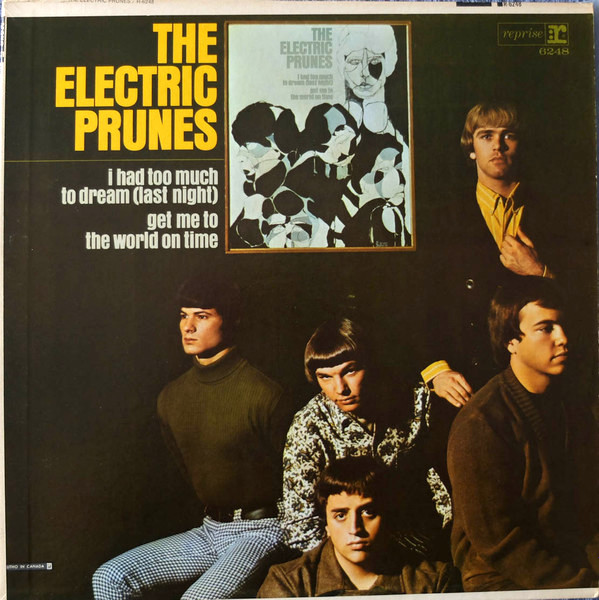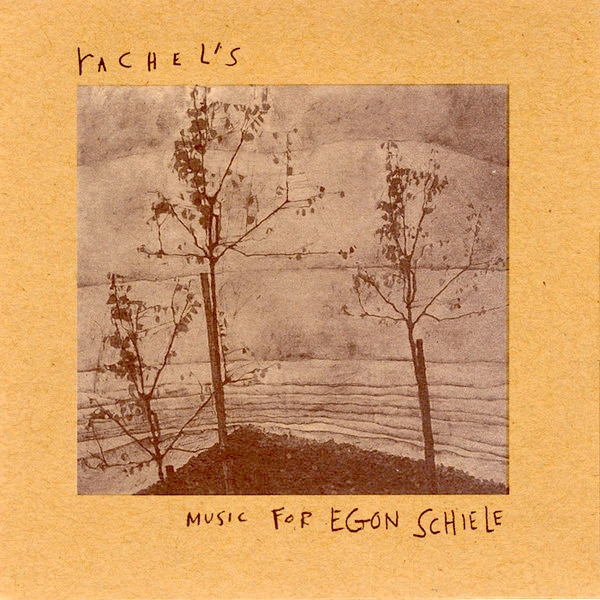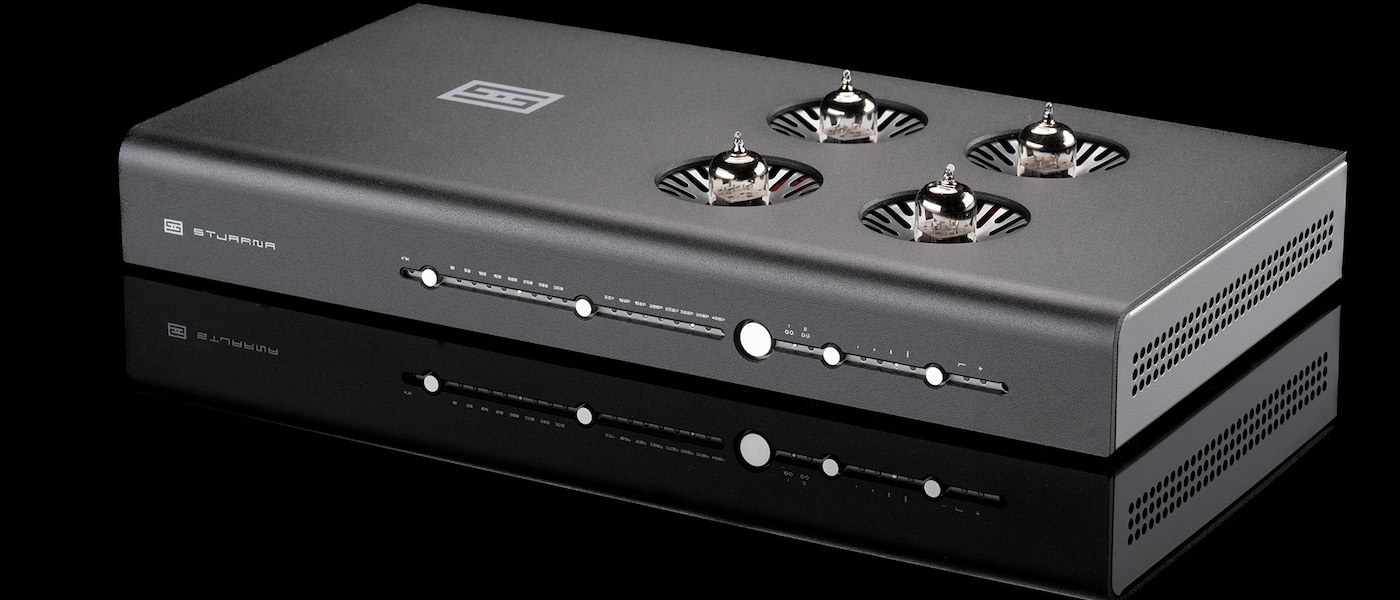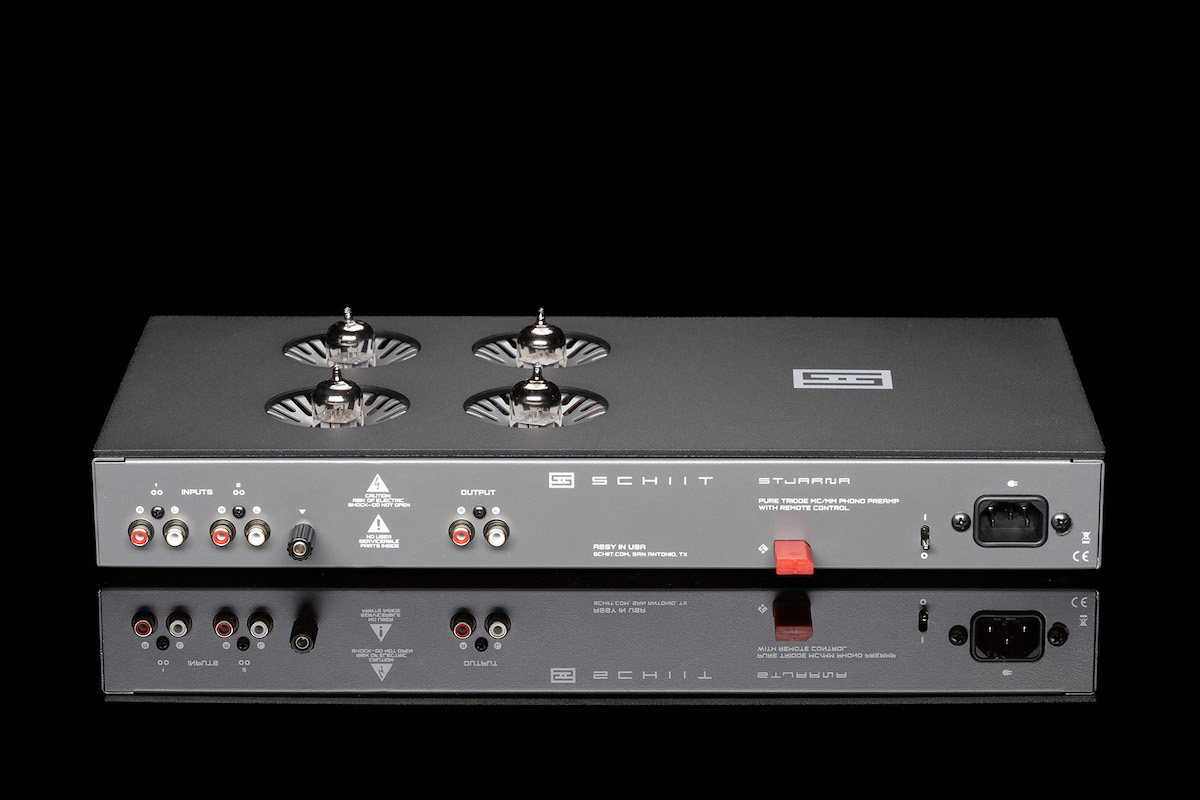It’s powered by tubes in a dual mono passive configuration with dead quiet power supplies. It provides an impressive set of features for its price, it can be easily controlled and configured in several ways for essentially any kind of phono cartridge, and it just plain gets out of the way and lets you hear the music that’s on your vinyl records. And you can even attach two tonearms to it and set it to play mono recordings.
I enjoyed every record I played through the Stjarna and found it very easy to configure to get the best sound out of a variety of phono cartridges. It was easy to set up and performed flawlessly.
Jason Stoddard and his team at Schiit Audio have been producing a steady stream of hits with their recent innovations in affordable audio. These include a new line of amplifiers with their Continuity and Nexus power designs, to redesigned DACs and headphone amps, to their new Forkbeard system, which enables you to integrate your Schiit components and control them all from a mobile application. I mean, the hits just keep coming. And another one of their latest hits is the Stjarna, their new tube-powered phono preamplifier.
Schiit Audio Stjarna Phono Preamplifier
- Inputs for two tonearms
- Enough gain to drive essentially any cartridge
- Provides pure tube power
- Can be configured for playing mono records
- Includes a physical remote control, or you can control it from your mobile device with the $50 Forkbeard module and free mobile application
- Comes with a 5-year warranty that covers parts and labor (except the tubes, which are covered for 3 months)
- Designed and built in the USA, like all Schiit Audio components
- Schiit Audio’s customer service and social media presences are strong, so it’s easy to find support
The Stjarna is the new phono preamplifier from Schiit Audio. It gives you up to 60dB of pure Class A tube gain from two dual-triode 6N1P tubes per channel. That means there are no step-up transformers, JFET pre-preamps, hidden op-amps, or cascodes in the signal chain. And that’s enough gain for moving coil (MC), moving iron (MI), and moving magnet (MM) cartridges. And it has inputs for two tonearms and features passive RIAA equalization, relay gain, LF filter, and, amazingly, mono mode. Glory be!
GAIN:
40dB
THD:
<0.16%, ref 2V RMS
SNR:
>82dB, A-weighted, ref 2V RMS
Crosstalk:
-100dB, 20-20kHz
Sensitivity:
2.85mV for 300mV output at 1kHz
GAIN:
48dB
THD:
<0.3%, ref 2V RMS
SNR:
>75dB, A-weighted, ref 2V RMS
Crosstalk:
-98dB, 20-20kHz
Sensitivity:
0.9mV for 300mV output at 1kHz
GAIN:
55dB
THD:
<0.4%, ref 2V RMS
SNR:
>70dB, A-weighted, ref 2V RMS
Crosstalk:
-95dB, 20-20kHz
Sensitivity:
0.6mV for 300mV output at 1kHz
GAIN:
60dB
THD:
<0.6%, ref 2V RMS
SNR:
>68dB, A-weighted, ref 2V RMS
Crosstalk:
-84dB, 20-20kHz
Sensitivity:
0.34mV for 300mV output at 1kHz
MAXIMUM OUTPUT:
30V RMS
OVERLOAD MARGIN:
>20dB
RIAA ACCURACY:
+/- 0.2dB, 20-20kHz
RUMBLE FILTER:
Switchable 2-pole at 15 Hz, fully passive
OUTPUT IMPEDANCE:
10 ohms
INPUT LOADING:
10-350 ohms and 47k ohms resistive, and 50-400pF capacitive, switched via Forkbeard, IR remote, or front-panel button.
TOPOLOGY:
Dual mono, pure Class A triode gain, 2 dual triode 6N1P tubes per channel, passive RIAA, with relay gain, LF filter, and mono switching. Tubes can be swapped with 6922/6DJ8 pinout dual triodes with 600mA of heater current or less
POWER SUPPLY:
Dual mono to the AC inlet, discrete CFP-regulated high voltage supplies (200V), precision-regulated DC heater supply with Schottky regulators and 44,000uF filter capacitance, standby shutdown for both HV and heater supplies.
POWER CONSUMPTION:
35W
SIZE:
Body: 16” wide x 8” long x 2” tall
Body with feet and typical tubes: 16” wide x 8” long x 3” tall
WEIGHT::
10 lbs.
MSRP:
$1,699
Website:
Company:
SECRETS Tags:
Schiit Audio, Stjarna, analog, turntable, moving magnet, moving iron, moving coil, tubes, preamplifier, remote control, reviews 2025
Secrets Sponsor
First, the history lesson. “Stjarna” is the old Norse word for “star.”
In order to create the Stjarna, the team at Schiit Audio set out to combine “the best technology of yesterday and today to create a cost-no-object phono preamp … featuring 100% tube gain, coupled with dead-quiet power supplies, remote control, and app integration that nobody in the tube era could have imagined.”
The Stjarna is completely dual mono back to the AC socket; there are two transformers, one for each channel, two separate discrete-regulated 200V power supplies, and two precision-regulated DC heater supplies. These are coupled with insane parts quality, such as 0.1% resistors and 1% film capacitors.
All of the Stjarna’s gain is from its tubes, and it runs in Class A. It is truly dual mono, with two tubes per channel and nothing being shared between channels. To keep the noise floor low, its heaters are DC regulated, and it runs a proper 200V for the tubes. There are no electronic switches or other shortcuts in the signal path. All input switching, gain switching, and loading are done by precision relays, which are controlled by a microprocessor running custom firmware. And finally, its power supply is discrete regulated for extremely low noise, and the microprocessor itself sleeps between commands, with its clock turned off to eliminate any potential interference.
For equalization, it uses passive RIAA with no feedback at all.
It follows the typical design language of Schiit Audio components, and its shape and dimensions mirror those of their Freya+ preamplifier. It is presently only available in a matte black finish with silver buttons and white LEDs on its face.
On its rear panel, from left to right, you’ll find two pairs of RCA inputs, a tonearm wire ground terminal, a single pair of RCA outputs, an input port for a Forkbeard module, a toggle switch for power, and an IEC power cord terminal. And on top are the four tube sockets, rather tastefully recessed into the chassis.
The Stjarna ships with four 6N1P triode tubes, and it was designed to use other tubes conforming to a 6922/6DJ8 pinout with 600mA or less heaters. You can use tubes like the 396A, but you’ll need an adapter. If you do try to run the Stjarna with incompatible tubes, its protection will kick in, and it will shut down. If the tubes fail, Schiit will sell you a new matched and noise-tested quad of replacement tubes for $80. Not bad at all.
Setting up the Stjarna was relatively straightforward, as setting up phono preamplifiers goes. I will admit that upon lifting it out of its box, I was surprised at its weight; this thing has some heft to it (though I should point out that, at 10 pounds, it weighs 1 pound less than my Freya + preamplifier). My point being, it may look pretty smooth on the outside, but the Stjarna has some serious iron underneath its skin.
Putting it into the system meant first installing the four tubes; the Stjarna won’t work without them. Then I connected the RCA output cable from the Jelco tonearm on my Thorens TD-124 into one pair of the Stjarna’s input terminals, and using the Stjarna’s single grounding terminal for the ground line attached to the Jelco’s tonearm cable. The rest of the system was basically just the incredible Vienna Acoustics Mozart Infinity active speakers. I ran a pair of 2M RCA interconnects out of the Stjarna and into the speakers’ RCA inputs.
I then attached the included IEC power cord and plugged it into one of my wall outlets, and turned on the Stjarna. The Stjarna runs diagnostics on itself when it powers up, and the leftmost white LEDs blink in sequence while this happens. Then the four tubes start glowing, and the five white LED indicators display what settings are currently selected.
There is quite a lot of functionality packed into the Stjarna, and you can control all of it from the face of the unit (or with the remote control, or with the Forkbeard application, but more on that later). On the face of the Stjarna is a row of 5 toggle switches with white LED indicator lights:
- Resistive load, which has 9 separate settings, from 10 to 250 ohms, or you can select the standard MM load of 47K. Also, the 47K LED glows when the Stjarna is in Standby mode (the heater and HV rails are completely off in Standby mode).
- Capacitive load, which has 7 separate settings:
- Input select, which lets you select between one of the two tonearm inputs.
- Gain select, which has four settings (40dB, 48dB, 55dB, and 60dB);
- Mode select, which lets you control two things: selecting between mono or stereo output and turning off or on the subsonic filter. You press and hold this button for 2 seconds to toggle mono on and off, and a short press toggles the subsonic filter. When the rumble filter “slope” LED is on, the rumble filter is on. When the “+” LED is on, the preamp is in mono mode.
This is where the real fun begins. You can use all five of these settings to get the Stjarna to sound as good as possible with the tonearm(s) and cartridge(s) you have connected to it. And you can change each setting without having to flip tiny DIP switches on the rear or removing the chassis and moving around jumpers. Yes, there are still a number of phono preamplifiers that require you to do those cumbersome and awkward things to change settings, both at and below the price of the Stjarna. Some of these phono preamplifiers also require you to power off the preamp before you change a setting, then power it up again.
Fortunately, the Stjarna has enough self-protection capability built into it that you can make changes on the fly. It will mute its output when you change the gain, to enable the circuitry to stabilize, for example, but that’s as far as the inconveniences go.
So, you just click through Resistive and Capacitive load settings until it sounds good, then find a Gain setting to make your preamplifier happy with the Stjarna’s output, and then you sit down and enjoy listening to your record.
As the manual says, “If you’re using a moving magnet (MM) cartridge, or high-output moving iron (some Grados), start with the lowest gain. If you’re using a moving coil (MC) cartridge, or low-output moving iron (other Grados), start with the highest gain. You can’t hurt anything; if stuff is distorted or too noisy, the gain is too high, so back off a bit.”
If your woofers flap around when you play music through the Stjarna, you can turn on the subsonic filter. And if you have a tonearm with a mono cartridge installed that has only one RCA output wire, you plug that one wire into the Stjarna, which will mix both channels together. I estimate that at least a quarter of all of my vinyl records are mono, and this is a feature I very much appreciate.
The Stjarna comes with the standard Schiit-style aluminum remote, powered by a watch battery. You can control the full functionality of the Stjarna with the remote, but the size of the text and icons printed on the remote is pretty small, so it takes a bit of muscle memory to get used to it.
Or, you can control the Stjarna with Forkbeard.
So, what is Forkbeard?
Forkbeard is Schiit Audio’s new “unified control system,” which enables you to control Schiit components from a mobile device. First, you need at least one of Schiit’s Forkbeard-enabled products (as of writing this, those are 3 DACs, 3 preamps, 2 phono preamps, and 5 amplifiers). You add a $50 Forkbeard module, which is a red plastic device about the size of a thumb drive, and insert it into its dedicated port on the rear of the device. Then you install and run the Forkbeard app on your mobile device (as of this writing, that’s iOS only; and yes, they’re working on an Android version). The app will automatically find any Forkbeard-enabled devices, and you can then control and configure them from your phone; no need to create an account.
There’s much more to Forkbeard, and you can get the rest of the details on Schiit’s website. But I will say that it is completely cool. I never imagined being able to configure a phono preamp with an app on my iPhone from the other side of the house, but now that I know that I can do it, I don’t want to live without it.
I tested the Stjarna with three cartridges installed on removable headshells for the Jelco SA-250 tonearm mounted for my Thorens TD-124 turntable. First was a Denon DL-103R in a Zu Audio aluminum body. This is a low-output moving coil cartridge with a .25mV output voltage. The second was an Audio Technica VM610MONO, a high-output moving magnet cartridge with a 3V output voltage.
Then, for comparison’s sake, I ran my Grado Platinum Statement high-output MC cart through the Stjarna. Now there was a big surprise. I’ve owned this cart for a number of years, and it has never really captured my full attention. By that I mean it plays music, but not in such an engaging way as my Denon DL-103 carts do; I find that the Grado lacks a certain energy and focus, whereas the DL-103s get more low-level detail and room acoustics out of the grooves. But when paired with the Stjarna, the Grado absolutely woke up. It felt like a butterfly coming out of its cocoon and spreading its wings. I got low-level detail and soundstaging I’d never heard before with this cart, and I started hearing details in albums I hadn’t heard before. I wasn’t surprised that the Stjarna enabled me to rediscover some of my favorite albums, but I did not expect it would enable me to rediscover one of my old cartridges.
I found the Stjarna’s sound quality to be fast, transparent, and extremely non-fatiguing. I was particularly impressed with how it handled low frequencies; bass guitars had very good focus, solidity, and presence. I know a lot of people see tubes and instantly expect muddy bass, or an over-emphasized or “glowing” midrange; you know, that “coloring” that turns some people off. I really did not get that impression with the Stjarna; it was the first all-tube preamp I’ve ever had that seemed to have finally figured out how to make a tube preamp work without any tradeoffs. Granted, the tube phono preamps I’ve had over the years were relatively inexpensive, but I found each one to be difficult to configure, prone to humming, or too colored, and I got rid of them all. The Stjarna sounds great, it’s easy to configure, and it just works, and I have no doubt it will provide its owner a great many years of good, reliable analog sound.
I also thought the Stjarna’s mid-range and top-range qualities were quite good. I heard good focus, especially with high frequencies, which went far to enable me to hear the full spectrum of frequencies available on the record. When I did hear distortion, it was because it was in the source recording, but even then, soundstaging and timbre were impressive for a component in this price range. This thing just has a knack for letting me hear the “human energy” in vinyl recordings without sounding too analytical or too fuzzy, like some components from the 1970s I’ve heard over the years. The Stjarna gave me the boogie, got my toes tapping, and showed me a real good time with each record I played through it. What more could you ask for from an audio component?

The Electric Prunes, “The Electric Prunes” (Rhino Records R1 6248, 2017)
This is the mono repress of the original Reprise release on purple vinyl, and it’s quite a stomper. The Audio Technica VM610MONO cartridge is relatively inexpensive and outputs 3V. After fine-tuning the Stjarna’s settings for that cart, I could hear each pudding-bowl haircut and pair of plaid polyester peg legs in the studio with this one. All kidding aside, I heard excellent separation of instruments and soundstaging from this album, and all the novelty of the studio trickery, like fuzz pedals and plate echo, came through, thanks to the Stjarna’s mono mode. I can’t wait to listen to all of my Capitol and Columbia mono records from the 1950s with this thing.

Rachel’s, “Music for Egon Schiele” (Quarterstick Records QS 35, 2025)
Absolutely gorgeous reissue on silver vinyl of this string ensemble’s masterpiece, first released in 1996. This music was written as the soundtrack for a live theater and dance production about Austrian painter Egon Schiele, who was born in 1890 and died at 28 years old of the Spanish flu, only three days after his wife died. The music is warm, bittersweet, expressive, and quiet, and through the Stjarna and the Zu Audio Denon DL-103R, I really felt its emotional impact. Timing of notes and the subtleties of the musicians’ gentle coaxing of their instruments were well portrayed, with the timbres of the cello and viola in particular being quite accurate and, well, human, due largely to the Stjarna’s tubes. I got the warmth of the tubes in the sound quality, but not the lack of focus I’ve encountered with other tubed phono preamplifiers. I feel that is quite an impressive feat at this price point, and one of the biggest selling points of the Stjarna.

Edward Ka-Spel, “Laugh China Doll (The Second Edition)” (LD Records LD 8942, 1989)
For an album that was recorded, mixed, and mastered in four days in a small, damp room in London in 1984, it sounds as though it was recorded in a large, damp Transylvanian castle. This particular vinyl release was actually mastered from a previous vinyl pressing, but I doubt you’d know that if you hadn’t read the liner notes. I’ve known this music for well over thirty years, but when I listened to it with my Grado Platinum Statement high-output MC cart, the music had a deeper and wider soundstage than I had previously experienced; the Stjarna showed me how Ka-Spel’s electronic and sampled sound effects swoop and swirl around the room, and I heard tones, timbres, and growls from the electronic sounds I didn’t know were there before. And isn’t it great when a new component helps you better connect with, and get more out of, a recording you’ve known for decades? I love when that happens.
Secrets Sponsor
It is a very good time to be a vinyl enthusiast. The number of turntables, tonearms, cartridges, preamplifiers, and accessories available across all price ranges for playing records has been growing for years.
- You get excellent tube sound with solid-state power and reliability.
- Fully adjustable and very easy to configure.
- It has a feature set that you’d have to spend much more to get from another manufacturer.
- You can configure it from a physical remote control or through your mobile device with Forkbeard.
- Easier to read text on the remote control and the face of the unit.
That means that competition for the enthusiasts’ dollars gets harder and harder for manufacturers to earn. The folks at Schiit Audio have risen to that challenge, and, through relentless innovation and continuous improvements, they sell audio components that provide excellent value for extremely reasonable prices.
The Stjarna phono preamplifier is a giant killer. For its $1,699 price tag, you get a very impressive set of features that would cost you $4,000 from other manufacturers. It provides non-fatiguing and detailed analog sound with the reliability of a solid-state architecture. It will work with essentially any kind of phono cartridge, and it has inputs for two cartridges. You can roll the tubes, and you can control it from your phone. I really can’t think of anything it can’t do. Highly recommended.







